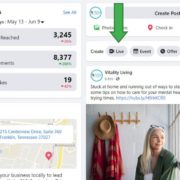Senior Living Social Media Marketing: High-Converting Content Ideas for Facebook
For the last couple of posts on our blog, we’ve been taking a deeper dive into senior living social media marketing. In case you missed them, here are the links:
In our experience, social media is one of the least understood marketing vehicles in our industry. Sure, we all “get” Facebook, at least from a personal perspective. But these platforms can provide an excellent way to reach prospects and engage with current residents and their families.
So, let’s turn our attention to content ideas for another social media platform popular with older adults: Facebook.
1. Share videos.
According to Social Media Today, video posts on Facebook generate more engagement (59% more!) than other types of posts. The same article offers up several other worthwhile tips. First, focus on shorter videos (90 seconds or less). Provide captions that entice people to watch. Make sure your video has a compelling thumbnail.
- Pro tip: Try “boosting” posts with videos. This is a form of Facebook advertising that lets you take an existing organic post that you then share with a wider target demo for a budget you set. Boosted posts can give you a good idea regarding which types of videos perform best (for example, a people-focused video vs. a tour video). Pay attention to video metrics (Facebook offers deep analytics known as Insights).
2. Experiment with Facebook Live.
Facebook Live takes videos to a whole new level because you’re sharing video footage in real time as it’s happening. (Thus, the word “Live.”) This isn’t some gimmick, either. Facebook Live works. In fact, HubSpot reports that Facebook lives generate 10 times more engagement than traditional videos.
You might wonder, “Well why should I bother with traditional videos at all then?” Two reasons.
First, you should be creating traditional videos for YouTube since, as we reported in a previous article, YouTube is currently the top social media platform with the Boomer generation (78%). You can’t ignore that stat! If you’re creating videos for YouTube, you’ll get a much bigger banger for your buck if you share that video content across other platforms, like Facebook.
Second, not everyone is comfortable doing something live. Not to mention, Facebook Live videos are often less polished than traditional videos. (Think shaky cameras or people going off “script” or videos simply going longer.)
Like everything else with senior living social media marketing, you want to have a smart strategy in place. And this strategy should include a mix of traditional videos and Facebook Live.
- Pro tip: We’ve written extensively about how senior living communities can use Facebook Live. Plus, we have a free guide for you to download on how to set up your first Facebook Live event.
3. Post images.
Facebook is a visual medium. As people scroll through their feed, they’re much more likely to stop on a captivating image rather than a block of text. In our next blog post, we’ll be talking about Instagram, which is ALL about images. The image suggestions we make in that post will most definitely apply to Facebook.
Here’s the overarching theme when it comes to Facebook images.
People, people, people. Think residents and their families. Staff members. Crowds from events like an author visit or Mother’s Day luncheon.
Spaces within your community. The pub, the salon, different room styles, dining areas (inside and out), fitness centers, views from various vantage points.
- Pro tip: Always include captions, which can help provide context.
4. Share testimonials.
Got a great review, comment from a resident, or sweet anecdote in a letter or email? Share it on Facebook (ideally with a pic for added visual interest).
- Pro tip: Whenever possible, include a picture of the person who gave the testimonial. And don’t just think in terms of residents and families. Testimonials from staff members can be great to share as well. And, of course, video testimonials are great as well.
5. Post important/relevant announcements.
Facebook can be a great way to get the word out about breaking news or important announcements. During the pandemic, many businesses communicated with people via social media (both through Facebook Live and “static” announcements).
For example, if your community is in the path of a hurricane, Facebook can be an excellent way to provide updates for families who are watching from afar and can’t get through to loved ones due to sketchy cell service and downed power lines.
- Pro tip: For shorter announcements that you want to stand out, use Facebook’s colorful background feature. It essentially turns your status update into a larger picture-type post (with bigger text and a colorful background—this makes it eye-catching). (Here’s how to do it.)
6. Share content from your community’s other digital assets.
Share your senior living blog posts on Facebook. (Write an engaging caption.) Share resources that followers will find helpful, like a guide for how to downsize a home. Share links to your podcasts. This is the cornerstone of effective senior living social media marketing.
- Pro tip: Make sure you pay attention to the analytics so that you can measure results. For example, if you share a link to a recent blog post, how much engagement did that Facebook post get (likes, clicks, comments)? And most importantly, how many people clicked FROM Facebook to your blog post? The goal is to get a better feel for what types of content get people to click so that you can post more of it.
7. Share content from relevant and reputable third-party sources.
For example, during the pandemic, linking to CDC and/or state guidelines made sense. Or you could share links to articles where your community or someone from your community is featured.
- Pro tip: Before sharing third-party content, always ask yourself if it will serve/help your target audience. Always check links. Always make sure you’re sharing accurate, properly vetted info. Avoid content that’s highly polarizing (such as political memes).












